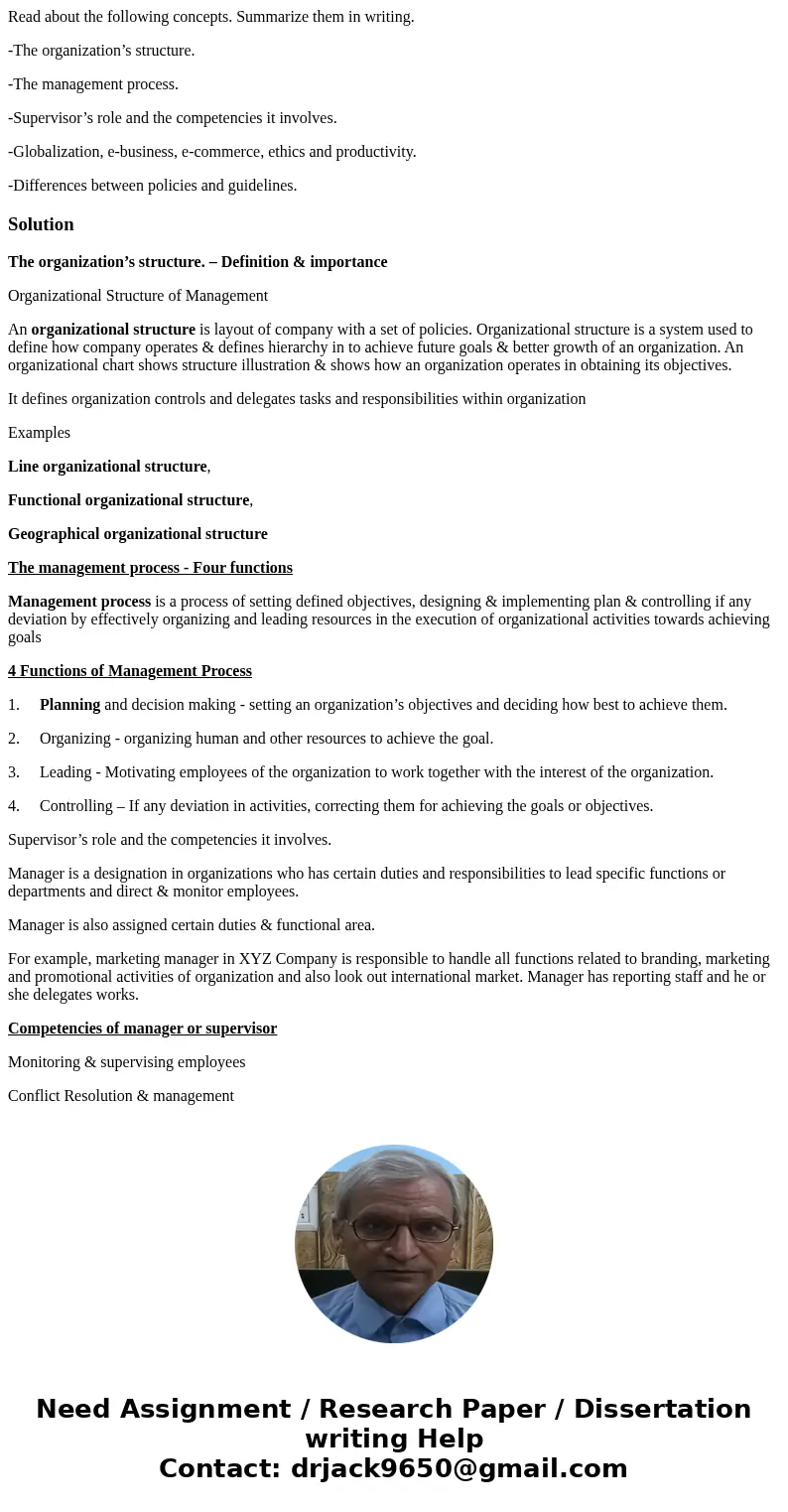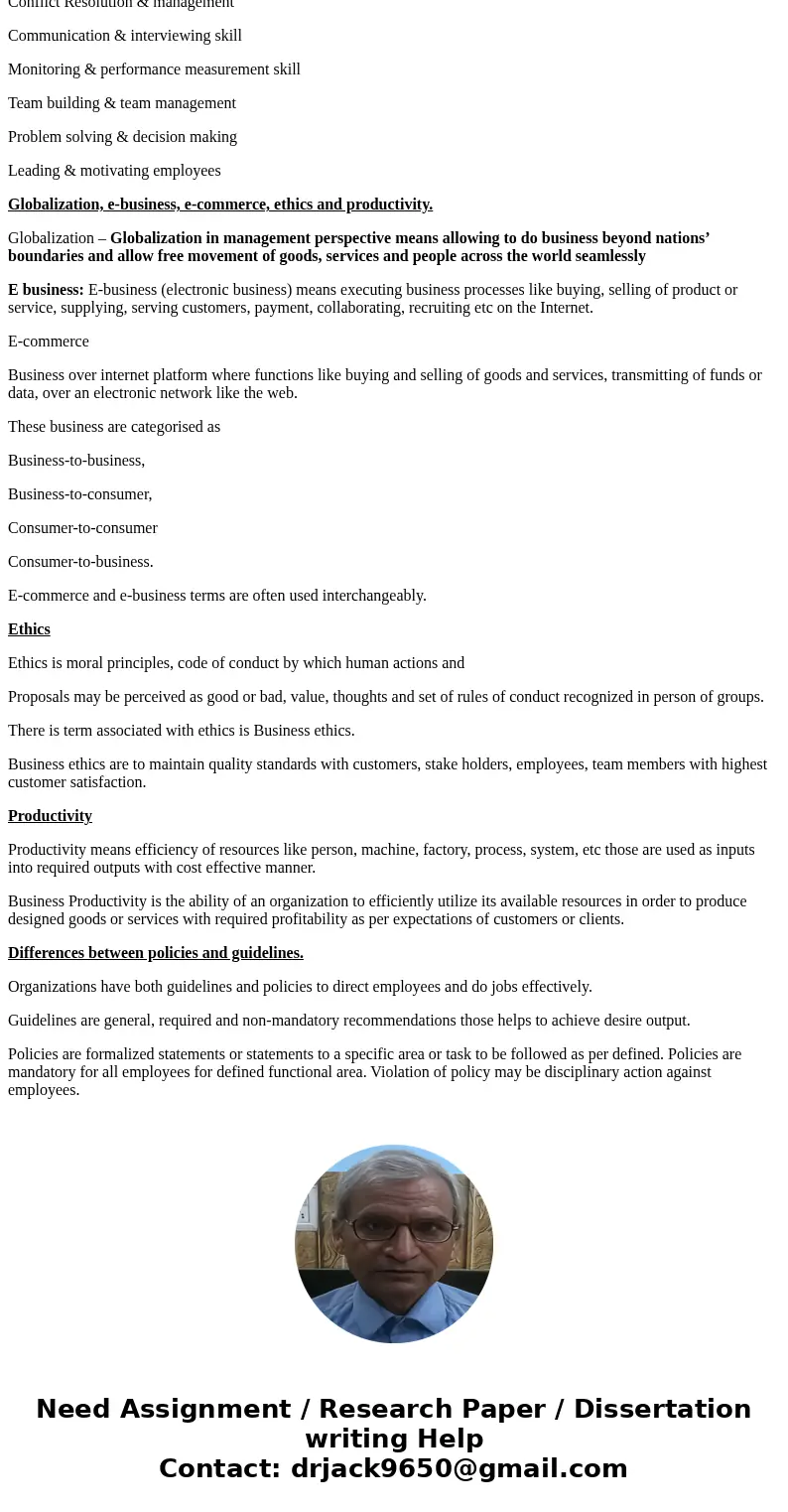Read about the following concepts Summarize them in writing
Read about the following concepts. Summarize them in writing.
-The organization’s structure.
-The management process.
-Supervisor’s role and the competencies it involves.
-Globalization, e-business, e-commerce, ethics and productivity.
-Differences between policies and guidelines.
Solution
The organization’s structure. – Definition & importance
Organizational Structure of Management
An organizational structure is layout of company with a set of policies. Organizational structure is a system used to define how company operates & defines hierarchy in to achieve future goals & better growth of an organization. An organizational chart shows structure illustration & shows how an organization operates in obtaining its objectives.
It defines organization controls and delegates tasks and responsibilities within organization
Examples
Line organizational structure,
Functional organizational structure,
Geographical organizational structure
The management process - Four functions
Management process is a process of setting defined objectives, designing & implementing plan & controlling if any deviation by effectively organizing and leading resources in the execution of organizational activities towards achieving goals
4 Functions of Management Process
1. Planning and decision making - setting an organization’s objectives and deciding how best to achieve them.
2. Organizing - organizing human and other resources to achieve the goal.
3. Leading - Motivating employees of the organization to work together with the interest of the organization.
4. Controlling – If any deviation in activities, correcting them for achieving the goals or objectives.
Supervisor’s role and the competencies it involves.
Manager is a designation in organizations who has certain duties and responsibilities to lead specific functions or departments and direct & monitor employees.
Manager is also assigned certain duties & functional area.
For example, marketing manager in XYZ Company is responsible to handle all functions related to branding, marketing and promotional activities of organization and also look out international market. Manager has reporting staff and he or she delegates works.
Competencies of manager or supervisor
Monitoring & supervising employees
Conflict Resolution & management
Communication & interviewing skill
Monitoring & performance measurement skill
Team building & team management
Problem solving & decision making
Leading & motivating employees
Globalization, e-business, e-commerce, ethics and productivity.
Globalization – Globalization in management perspective means allowing to do business beyond nations’ boundaries and allow free movement of goods, services and people across the world seamlessly
E business: E-business (electronic business) means executing business processes like buying, selling of product or service, supplying, serving customers, payment, collaborating, recruiting etc on the Internet.
E-commerce
Business over internet platform where functions like buying and selling of goods and services, transmitting of funds or data, over an electronic network like the web.
These business are categorised as
Business-to-business,
Business-to-consumer,
Consumer-to-consumer
Consumer-to-business.
E-commerce and e-business terms are often used interchangeably.
Ethics
Ethics is moral principles, code of conduct by which human actions and
Proposals may be perceived as good or bad, value, thoughts and set of rules of conduct recognized in person of groups.
There is term associated with ethics is Business ethics.
Business ethics are to maintain quality standards with customers, stake holders, employees, team members with highest customer satisfaction.
Productivity
Productivity means efficiency of resources like person, machine, factory, process, system, etc those are used as inputs into required outputs with cost effective manner.
Business Productivity is the ability of an organization to efficiently utilize its available resources in order to produce designed goods or services with required profitability as per expectations of customers or clients.
Differences between policies and guidelines.
Organizations have both guidelines and policies to direct employees and do jobs effectively.
Guidelines are general, required and non-mandatory recommendations those helps to achieve desire output.
Policies are formalized statements or statements to a specific area or task to be followed as per defined. Policies are mandatory for all employees for defined functional area. Violation of policy may be disciplinary action against employees.


 Homework Sourse
Homework Sourse